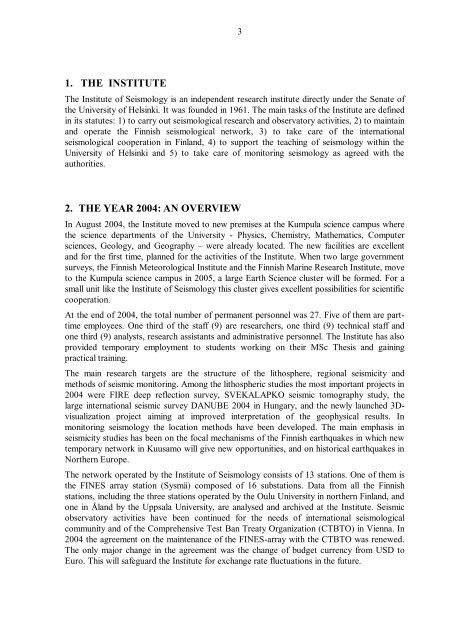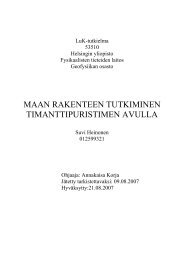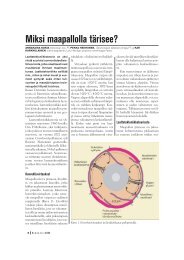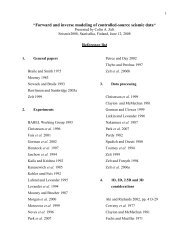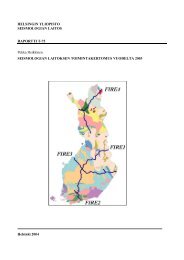Annual report 2004 - Helsinki.fi
Annual report 2004 - Helsinki.fi
Annual report 2004 - Helsinki.fi
You also want an ePaper? Increase the reach of your titles
YUMPU automatically turns print PDFs into web optimized ePapers that Google loves.
3<br />
1. THE INSTITUTE<br />
The Institute of Seismology is an independent research institute directly under the Senate of<br />
the University of <strong>Helsinki</strong>. It was founded in 1961. The main tasks of the Institute are de<strong>fi</strong>ned<br />
in its statutes: 1) to carry out seismological research and observatory activities, 2) to maintain<br />
and operate the Finnish seismological network, 3) to take care of the international<br />
seismological cooperation in Finland, 4) to support the teaching of seismology within the<br />
University of <strong>Helsinki</strong> and 5) to take care of monitoring seismology as agreed with the<br />
authorities.<br />
2. THE YEAR <strong>2004</strong>: AN OVERVIEW<br />
In August <strong>2004</strong>, the Institute moved to new premises at the Kumpula science campus where<br />
the science departments of the University Physics, Chemistry, Mathematics, Computer<br />
sciences, Geology, and Geography –were already located. The new facilities are excellent<br />
and for the <strong>fi</strong>rst time, planned for the activities of the Institute. When two large government<br />
surveys, the Finnish Meteorological Institute and the Finnish Marine Research Institute, move<br />
to the Kumpula science campus in 2005, a large Earth Science cluster will be formed. For a<br />
small unit like the Institute of Seismology this cluster gives excellent possibilities for scienti<strong>fi</strong>c<br />
cooperation.<br />
At the end of <strong>2004</strong>, the total number of permanent personnel was 27. Five of them are parttime<br />
employees. One third of the staff (9) are researchers, one third (9) technical staff and<br />
one third (9) analysts, research assistants and administrative personnel. The Institute has also<br />
provided temporary employment to students working on their MSc Thesis and gaining<br />
practical training.<br />
The main research targets are the structure of the lithosphere, regional seismicity and<br />
methods of seismic monitoring. Among the lithospheric studies the most important projects in<br />
<strong>2004</strong> were FIRE deep reflection survey, SVEKALAPKO seismic tomography study, the<br />
large international seismic survey DANUBE <strong>2004</strong> in Hungary, and the newly launched 3Dvisualization<br />
project aiming at improved interpretation of the geophysical results. In<br />
monitoring seismology the location methods have been developed. The main emphasis in<br />
seismicity studies has been on the focal mechanisms of the Finnish earthquakes in which new<br />
temporary network in Kuusamo will give new opportunities, and on historical earthquakes in<br />
Northern Europe.<br />
The network operated by the Institute of Seismology consists of 13 stations. One of them is<br />
the FINES array station (Sysmä) composed of 16 substations. Data from all the Finnish<br />
stations, including the three stations operated by the Oulu University in northern Finland, and<br />
one in Åland by the Uppsala University, are analysed and archived at the Institute. Seismic<br />
observatory activities have been continued for the needs of international seismological<br />
community and of the Comprehensive Test Ban Treaty Organization (CTBTO) in Vienna. In<br />
<strong>2004</strong> the agreement on the maintenance of the FINESarray with the CTBTO was renewed.<br />
The only major change in the agreement was the change of budget currency from USD to<br />
Euro. This will safeguard the Institute for exchange rate fluctuations in the future.


